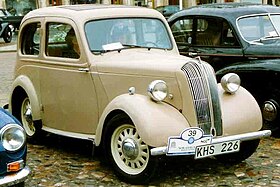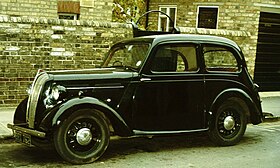Standard Eight
| Standard Eight | |
|---|---|

Standard 8hp Saloon of 1946
|
|
| Overview | |
| Manufacturer | Standard-Triumph |
| Production | 1938–59 |
| Chronology | |
| Predecessor | none |
| Successor | Triumph Herald |
| Standard Flying Eight | |
|---|---|

1939 Standard Flying Eight Saloon
|
|
| Overview | |
| Production | 1938–41 |
| Body and chassis | |
| Body style |
|
| Powertrain | |
| Engine | 1021 cc I4 |
| Transmission | 3-speed manual |
| Dimensions | |
| Wheelbase | 83 in (2,100 mm) |
| Length | 139 in (3,500 mm) |
| Width | 56 in (1,400 mm) |
| Standard 8 hp | |
|---|---|

Standard 8hp Tourer of 1947
|
|
| Overview | |
| Production |
|
| Assembly |
|
| Body and chassis | |
| Body style |
|
| Powertrain | |
| Engine | 1009 cc I4 |
| Transmission | Four-speed manual |
| Dimensions | |
| Wheelbase | 83 in (2,108 mm) |
| Length | 139 in (3,531 mm) |
| Width | 56 in (1,422 mm) |
| Standard Eight | |
|---|---|
 |
|
| Overview | |
| Also called | Vanguard Cadet |
| Production |
|
| Designer | Vic Hammond |
| Body and chassis | |
| Body style | 4-door saloon |
| Powertrain | |
| Engine | 803 cc SC OHV I4 |
| Transmission |
|
| Dimensions | |
| Wheelbase | 84 in (2,134 mm) |
| Length | 144 in (3,658 mm) |
| Width | 60 in (1,524 mm) |
The Standard Eight is a small car produced by the British Standard Motor Company from 1938 to 1959.
The car was originally launched in 1938 as the Flying Eight. After the Second World War the Flying range of Standards was dropped but an updated car called the 8 hp was re-introduced in 1945. In 1953 a completely new car, the Standard Eight was launched sharing virtually nothing with its predecessor. In 1959 the car was dropped to be replaced by the Triumph Herald, as the Standard brand was being phased out.
The Flying Eight was the smallest member of the Standard Flying family. It was launched by the Standard Motor Co Ltd late September 1938, prior to the 1938 Motor Show at Earls Court in October of that year. Apart from the power unit, it was a brand new design, and marked Standard's first entry into the smallest 8 hp market.
The frame was all new, with box section longitudinals, and independent front suspension (ifs) by a transverse leaf spring. It was the first British 8 hp family car to feature ifs. At the same time, an updated Flying Ten and a Flying Twelve were introduced, incorporating the same chassis features. The engine was a development of the previous Flying Nine/Ten, but now with a counterbalanced crankshaft and an aluminium cylinder head. The bore was reduced to 57 mm in order to get into the 8 hp class, while the stroke remained at 100 mm. At 1,021 cc swept volume, maximum power was quoted to 31 bhp at 4,000 rpm. A 3-speed gearbox was used, as well as Bendix mechanical brakes operated by cables.
Two versions were available from the launch of the model: A two-door all-steel saloon, and a 2/4-seat open tourer. The former body was built for Standard by Fisher & Ludlow at a newly erected plant at Tile Hill, Coventry. The open tourer bodies were built by Carbodies at Holyhead Road, Coventry, and these cars were probably also assembled there. These tourers featured cut-down door tops, and a fold-flat windscreen.
Around the turn of the year 1938/39 a drophead coupe became available. This body was built for Standard by Mulliners of Birmingham, who were already building drophead bodies for the Standard Flying Twelve. The initiative for this version probably came from Mulliner's and not from Standard themselves, as it appeared 4–5 months after the original saloon and tourer versions.
The prewar production ledger has not survived. The saloon and tourer prototypes (DDU 514 and −516 respectively) were both registered on 15 February 1938. However, series production of the saloons at Standard's Canley plant seems to have commenced early September 1938, and it seems probable that 23,069 home market (RHD) saloons had been assembled by the end of August 1939 (end of company's 1938/39 financial year). The number of home market open tourers seem to be 1,500 (two batches of 1,000 and 500 respectively). Assembly of these seem to have begun in early November 1938, and continued uninterrupted until about July 1939. Number of drophead coupes were certainly less than 1,000 – only one proper batch of 500 has been identified. 550 left hand drive (LHD) completely knocked down (CKD) sets were supplied to Denmark for assembly by their importers, Bohnstedt-Petersen AS in Copenhagen. 500 of these were saloons, 50 were open tourers. CKD sets were also supplied to Australia, and assembled there by Mortlocks of Perth. For open tourers they used locally built bodies by Richards. The number of Flying Eights assembled in Australia is unknown. Production at Standard's Canley plant continued into the early weeks of 1940. The highest chassis number now known is 33433, a saloon first registered on 11.7.1940. The Glass Guide quotes 34,601 as the final pre-war (saloon?) chassis number.
...
Wikipedia
